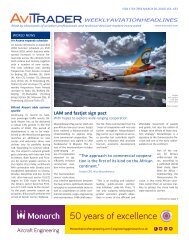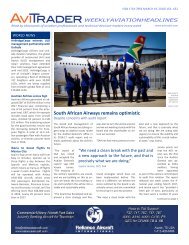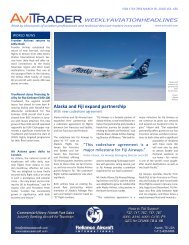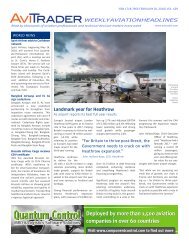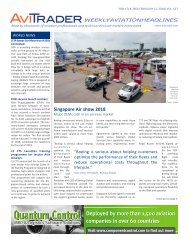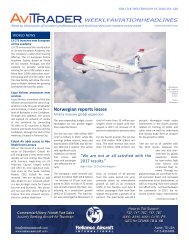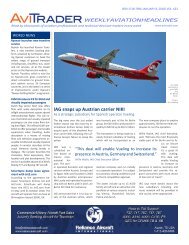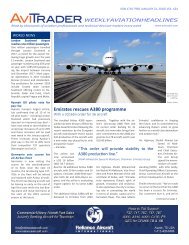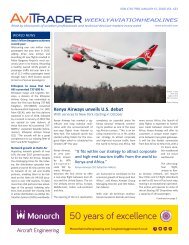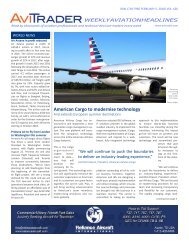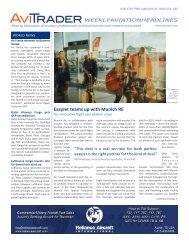AviTrader_Monthly_MRO_e-Magazine_2017-12
AviTrader_Monthly_MRO_e-Magazine_2017-12
AviTrader_Monthly_MRO_e-Magazine_2017-12
You also want an ePaper? Increase the reach of your titles
YUMPU automatically turns print PDFs into web optimized ePapers that Google loves.
Cover story: <strong>MRO</strong> North America<br />
20<br />
American airports. Moabery<br />
adds: “This is being done to accommodate<br />
the air travel growth<br />
in those regions and the development<br />
of large network hubs to<br />
capitalising on the growth. Ultimately,<br />
the result is that global<br />
maintenance capacity will grow<br />
and if those regions can continue<br />
to develop a labour pool,<br />
the long-term horizon will reflect<br />
a North American <strong>MRO</strong> market<br />
that supports airlines within a<br />
tight perimeter of the continent.<br />
The days of airlines flying in to<br />
North America to perform maintenance<br />
are gone forever.”<br />
If the forecasters are correct<br />
about fleet activities in North<br />
America declining in favour of<br />
emerging markets in the Middle<br />
East and China, then the <strong>MRO</strong><br />
requirements will go the same<br />
way reckons Kleiman. “This trend<br />
is partially what is driving AAR’s<br />
global expansion in those regions.”<br />
Kellstrom Vortex Fort Lauderdale.<br />
Photo: Kellstrom Aerospace<br />
they also develop their own <strong>MRO</strong> sectors, which adds globally capacity.<br />
“Now, it does not make a lot of sense for an airline to fly<br />
10,000 miles to do maintenance on a short-haul aircraft, but let’s<br />
say that an aircraft is returned from lease and the North American<br />
lessor wants to bridge maintenance for the next customer. That lessor<br />
now has regional <strong>MRO</strong> options that cannibalise a once robust<br />
North American <strong>MRO</strong> market,” says Moabery.<br />
Experts project the next 10 years will see a significant shift in the<br />
relative distribution of passenger traffic, moving the epicentre of<br />
demand and related fleet activity away from North America to<br />
strong emerging markets in the Middle East and China for instance.<br />
In the past year, AAR has further<br />
expanded its global reach by<br />
signing a long-term contract with<br />
Dubai-based flydubai for comprehensive<br />
flight-hour component<br />
support for its new Boeing<br />
737 MAX aircraft, and a global<br />
supply chain network with a new<br />
warehouse in Shanghai. AAR<br />
has also been approached by local<br />
partners in these regions to<br />
provide expertise on the establishment<br />
and operation of heavy<br />
maintenance <strong>MRO</strong>s.<br />
“AAR has also expanded our<br />
parts supply inventory, which is already the largest volume of new<br />
and used parts in the industry, to include ATR parts for a platform<br />
more commonly used outside the U.S. We also expanded AAR’s inhouse<br />
component repair network to Southeast Asia through a partnership<br />
with Air New Zealand’s component centre,” says Kleiman.<br />
Ultimately, its widely agreed that the North American market will<br />
remain attractive, and while the region might not be growing as<br />
quickly, it will remain a large, mature market.<br />
Moabery highlights the growing middle-class in countries like<br />
China and India that are fuelling the growth of air travel in those<br />
regions. “This will drive airline growth in those regions at a faster<br />
rate than airlines in North America,” he states.<br />
Additionally, over the next five years, there are major airports being<br />
built that double and triple the capacity capabilities of North<br />
<strong>AviTrader</strong> <strong>MRO</strong> - December <strong>2017</strong>





